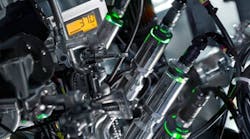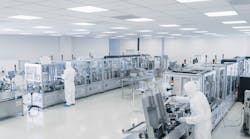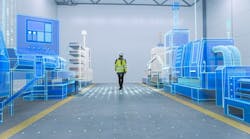Is your pharma facility protected from weather and unintended abuse threatening its roof? When a roof is neglected, human-caused and environmental elements can lead to premature commercial roof failure. You take care of your laboratory and manufacturing equipment. The same logic applies to roofs.
Since roofs are often out of sight and out of mind, roofs are not a priority until an emergency happens. Proactive management can minimize the impact of premature roof failure, improve reliability and save money.
Proactive roof management allows facilities to confront three issues:
1) Safety incidents – Water intrusion can cause safety and health incidents and overall manufacturing issues. This includes potential contamination risk.
2) Operational disruptions – Rainwater can damage inventory and valuable equipment. A leaky roof can also cause production delays and disrupt clinical trials.
3) Budget emergencies – An unanticipated roof failure can completely drain your capital budget, which means that other critical projects are deferred.
These issues are unacceptable for pharma facilities who rely on weather-tight buildings.
A proactive roof asset management program will break this expensive reactionary cycle. Roof asset management will:
• Find and prevent leaks before equipment and inventory is damaged
• Maintain the roof to a high-performing level
• Extend the service life of existing roofs
• Meet warranty requirements to keep coverage
• Prevent unanticipated and unnecessary spending and stress
• Result in the lowest total cost of ownership for your roof assets now and in the future
Many roof management approaches exist. An approach that delivers roof reliability and cost-savings across a large facility portfolio would likely have six components:
1. Data Management and Planning – The documentation and data of the roof assets combined with expert insight builds a strategic plan for roof management over the lifetime of the roof.
2. Emergency Response – A quick response to roofing issues is critical, especially with emergency leaks. It is also important to make sure repairs are permanent and part of a strategic plan. Take caution of suggested temporary fixes as this is usually short-sighted thinking.
3. Preventive Maintenance – Facility managers are responsible for roof maintenance. This is important to both preserve the life of the roofs and keep warranty coverage.
Every building manager maintains the roof system in their own way, and each contractor builds a roof system differently. Therefore, all roofs have a unique life cycle. All roof types do not age the same way.
However, when a roof reaches mid-life, it exponentially degrades to a point where no repair or restoration can fix it. You can prolong this decline and reduce future replacement costs through regular preventive maintenance.
4. Repairs – A best practice in roof asset management is to identify repairs as you do preventive maintenance or get an inspection. The next step is to prioritize repairs based on need and schedule this work annually. If you get the corrective repair work done once a year then the work is one bundled, cost-effective project.
5. Roof Restoration – Roof restoration, also known as rehabilitation, is the long-term restoration of the roof system. Restoration is the more viable and cost-effective option compared to a total roof replacement. If you find a roof defect beyond the point of restoration then the work becomes a costly replacement project, so it is crucial to catch defects quickly.
6. Roof Replacement – A qualified roof consultant can predict when a facility needs a roof replacement based on the components in the management program. They will create a guide for smooth year over year spending, which is favorable since the cost of replacements run high.
Regardless if your building is a new state-of-the-art or aging facility, excellent roof performance should be a goal for pharmaceutical manufacturing facilities. If that becomes your goal, look for an asset management program with these six components to prevent degradation, reduce leaks, and, consequently, reduce future costs and gain budget continuity.
Consider this success story from a global pharma company’s research campus in the midwest. Facility management played a critical role in its premium research environment that includes laboratories, office space and computing facilities. Additionally, it achieved roof reliability at a reduced fiscal burden.
The facilities at the midwest campus were in mid-life, approximately 30-years-old. Over time, the buildings on this campus were expanded, renovated and modified without a coherent, comprehensive roof management strategy. As a result, the campus had extensive leaks, failing roofs and unanticipated budget surprises.
The campus started a roof asset management program to overcome these issues. The first year of management stabilized the roofs and built a long-term strategic plan. Phase two in the second year shifted to proactive management. This addressed the repair backlog proposed in the plan. The ongoing work optimized the leak response management and placed high priority on the restorations and replacements for the roof assets. It also scheduled annual assessments and preventive maintenance.
The third phase is when the campus scaled their cost-savings and achieved a balanced capital program. This phase created life extension for the roofs, opportunities to restore roofs versus getting replacements, and budget certainty for those anticipated replacement projects.
The program saved the campus five percent from their baseline spending in the first phase, 15 percent in spending the second phase, and 40 percent in spending in the third phase. The continued proactive measures to extend roof service life and preserve the option for restoration will save the campus 1.6 million dollars over the next 10 years.
Every pharma facility is different, but facilities have the potential to see on average a 25-30 percent reduction in roof expenditures and a 50-75 percent reduction in leaks and associated damage through proactive roof asset management.
Richard Rast founded BLUEFIN in 2005 and has over 30 years of experience providing facility asset, energy management, consulting, and technology expertise to the facilities industry.
[javascriptSnippet]





